

Spotlight on Personalized Learning. The Education Week Spotlight on Personalized Learning is a collection of articles hand-picked by our editors for their insights on: Using new technologies and teaching approaches to improve learning in middle schoolsCreating individualized education plans for every studentConducting personalized assessment of studentsCombining face-to-face instruction and online learning Developing online credit-recovery courses to motivate underachieving students You get the nine articles below and a resource guide in a downloadable PDF, a great value!

A Vermont initiative to improve learning in middle schools is working through the challenges of using the latest digital tools and different teaching approaches. March 14, 2011 - Education Week Targeting students' individual needs could help build a kind of individualized education plan for every student. January 29, 2010 - Digital Directions Determining what approaches work best when using digital tools to customize education is proving to be challenging. Biography of Maria Montessori. Maria Montessori was an Italian physician, educator, and innovator, acclaimed for her educational method that builds on the way children naturally learn.
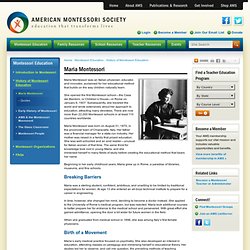
She opened the first Montessori school—the Casa dei Bambini, or Children’s House—in Rome on January 6, 1907. Subsequently, she traveled the world and wrote extensively about her approach to education, attracting many devotees. There are now more than 22,000 Montessori schools in at least 110 countries worldwide. Maria Montessori was born on August 31, 1870, in the provincial town of Chiaravalle, Italy. Her father was a financial manager for a state-run industry.
Beginning in her early childhood years, Maria grew up in Rome, a paradise of libraries, museums, and fine schools. Breaking Barriers Maria was a sterling student, confident, ambitious, and unwilling to be limited by traditional expectations for women. Powering Personalized Learning Infographic. K12 Infographics The current way student records and transcripts are managed is insufficient to meet the evolving needs of teachers, students, and parents.

Why does Learner Centred Instruction Matter? Why does Learner Centred Instruction Matter?
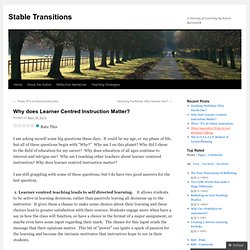
I am asking myself some big questions these days. It could be my age, or my phase of life, but all of these questions begin with “Why?” Why am I on this planet? Why did I chose to the field of education for my career? Why does education of all ages continue to interest and intrigue me? I am still grappling with some of these questions, but I do have two good answers for the last question. 1. Individualize. Introduction.
Don’t standardize education, personalize it. Home. RtI in a Personalized Learning Environment. What is RtI?
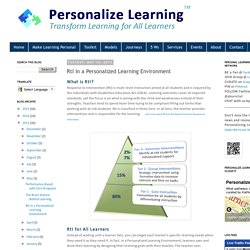
Response to Intervention (RtI) is multi-level instruction aimed at all students and is required by the Individuals with Disabilities Education Act (IDEA). Learning outcomes cover all required standards, yet the focus is on what is wrong with the child and weaknesses instead of their strengths. Teachers tend to spend more time trying to be compliant filling out forms than working with at-risk students. RtI is classified in three tiers. In all tiers, the teacher provides interventions and is responsible for the learning.Learn more about RtI from the National Center for Response to Intervention RtI for All Learners. Personalized Learning. What Is Personalized Learning? Personalized Learning puts the needs of students FIRST! Personalized Learning honors each student as an individual learner, recognizes that each student has his or her own learning style, unique gifts, interests, aspirations, and challenges to learning, and supports each student to learn in his or her own unique way.
Personalized Learning is a blended approach to learning that combines the delivery of education both within and beyond the traditional classroom environment. The Personalized Learning model fosters a collaborative partnership between the teacher, parent, student and school that designs a tailored learning program for each student according to the needs and interests of each individual student. The key attributes that comprise the Personalized Learning model are based upon a solid foundation of the latest educational research findings as to how students learn most successfully. Why? 10 Predictions for Personalized Learning for 20... Student-Centered Learning. Student-centered learning or student-centered learning is an approach to education focusing on the needs of the students, rather than those of others involved in the educational process, such as teachers and administrators.
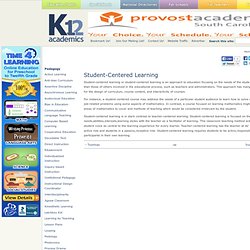
This approach has many implications for the design of curriculum, course content, and interactivity of courses. For instance, a student-centered course may address the needs of a particular student audience to learn how to solve some job-related problems using some aspects of mathematics. What it is - Building Learning Power. Building Learning Power has one big ambition, based on three core beliefs, nurtured by three root systems, leading to a revolution in learning.
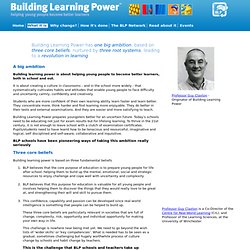
A big ambition Building learning power is about helping young people to become better learners, both in school and out. It is about creating a culture in classrooms - and in the school more widely - that systematically cultivates habits and attitudes that enable young people to face difficulty and uncertainty calmly, confidently and creatively. Learning Styles ~ Personalized Education. How Can Teachers Create a Learner-Centered Environment? - Leading From the Classroom.
Personalized Learning Puts Students In A Class Of Their Own. A new learning platform is giving the traditional classroom a radical makeover.

Using innovative ICT technology, iClass is putting pupils at the centre of the learning experience and providing them with more control over what they learn. Every parent believes their child is unique. And they are right. Every pupil has their own individual strengths and weaknesses, and their own particular way of learning.
However, putting this commonsense observation into practice is no mean feat, and our schools have generally not been very successful at personalising the learning experience. In fact, the image of classrooms as ‘knowledge factories’ has not changed much since the Industrial Revolution, despite the major advances in teaching methods that have occurred. “A school is not a factory,” bemoaned British novelist JL Carr in his acclaimed novel, The Harpole Report, which tells the story of a primary school headmaster. Learner Centered. UDL Guides Personalized Learning. "Many children struggle in schools... because the way they are being taught is in the way that is incompatible with the way they learn.

" Peter Senge Universal Design for Learning® (UDL) is the lens to guide the design of Personalized Learning Environments. UDL is based on neuroscience and how we learn. There are some misperceptions about UDL. When the learner understands how to use the UDL principles to understand how they learn best, they own and drive their learning. When learners know how they prefer or need to access information, engage with the content, and express what they know and understand, then they take responsibility for their learning. Diagram by Barbara Bray and Kathleen McClaskey are licensed under a Creative Commons Attribution-NonCommercial-NoDerivs 3.0 Unported License. Teacher vs Learner centered instruction. CultureShift.pdf. Inclusion in the 21st-century classroom: Differentiating with technology - Reaching every learner: Differentiating instruction in theory and practice.
In this video, students in a gifted classroom use the multi-user learning environment Quest Atlantis to explore issues related to the creation of a game reserve in Tanzania.
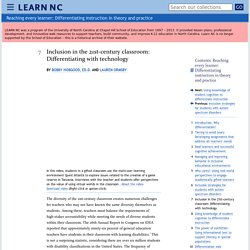
Interviews with the teacher and students offer perspectives on the value of using virtual worlds in the classroom . About the videoDownload video (Right-click or option-click) The diversity of the 21st-century classroom creates numerous challenges for teachers who may not have known the same diversity themselves as students. Among these, teachers must balance the requirements of high-stakes accountability while meeting the needs of diverse students within their classroom. The 26th Annual Report to Congress on IDEA reported that approximately ninety-six percent of general education teachers have students in their classroom with learning disabilities.
Differentiation as effective instruction Overcoming obstacles to effective differentiation Setting the scope A framework for technology integration. Defining Personalized Learning.